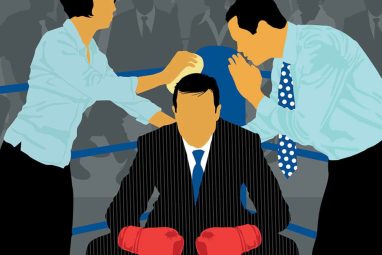How the Smartest CEOs Start
Find the right balance between listening and learning versus acting in this excerpt from The New CEO.
News
- OpenAI Flags ‘High’ Cyber Risk as State AGs Warn Industry Over Harmful Chatbot Outputs
- Riyadh Air, IBM partner to Launch World's First AI-Native Airline
- Adobe Leans Into AI to Defend Its Creative Tech Lead in 2026
- Khazna Strengthens Saudi Presence With New Country Head to Drive AI-Ready Infrastructure Growth
- Debt, Data Centers, and OpenAI Dependence Put Oracle Under Pressure
- Qatar Launches Qai, a National AI Company Backed by the Sovereign Wealth Fund

Carolyn Geason-Beissel/MIT SMR
The hardest part of a CEO transition is finding the right balance between listening and learning versus acting. How fast is too fast? How slow is too slow?
Do you come in and take immediate action to make things better and have an impact? Or do you keep your powder dry while you move around the organization listening, engaging, and learning?
I have had these conversations with every CEO I have worked with, often several times over and again:
Should I take my time and learn the organization?
Yes.
But if I move too slowly, do I run the risk of the board getting rid of me?
Yes.
Do people need to feel the impact of a new CEO?
Yes.
But do I run the risk of losing people because I move too fast?
Yes.
So, what should I do — be patient or go fast?
… Yes!
The hard truth is that it is impossible to answer the final question definitively. There is no answer that is always right, all of the time. Unfortunately, the CEO role is full of paradoxes, contradictions, and judgment calls — especially when you’re in transition.
The decision about how fast to go — and what to focus on — will be heavily influenced by the organizational context you face. Sometimes, the situation will dictate that you can’t wait — for example, in the context of a turnaround or when joining an organization in crisis. In other scenarios, it will pay to slow down or scale back your actions.
But from my privileged position of sitting alongside CEOs in transition (and not being one of them), it is easy to answer the question about how fast to move. The answer is, of course, you should act as fast as you can, once you have learned what you need to learn to make good decisions.
The hard truth is that it is impossible to answer the final question definitively. There is no answer that is always right, all of the time. Unfortunately, the CEO role is full of paradoxes, contradictions, and judgment calls — especially when you’re in transition.
The decision about how fast to go — and what to focus on — will be heavily influenced by the organizational context you face. Sometimes, the situation will dictate that you can’t wait — for example, in the context of a turnaround or when joining an organization in crisis. In other scenarios, it will pay to slow down or scale back your actions.
But from my privileged position of sitting alongside CEOs in transition (and not being one of them), it is easy to answer the question about how fast to move. The answer is, of course, you should act as fast as you can, once you have learned what you need to learn to make good decisions.
Some general principles can help you navigate this complex and high-stakes balancing act in your CEO journey. Not all will apply to you, but they should help you understand the scenarios where you can slow down while still showcasing your intentions as a new CEO — and situations where you have no choice but to go big or go home.
Rethink the ‘First 100 Days’ Mindset
When there is a new president, national leader, and, yes, CEO, there is intense focus on their first 100 days: what they plan to do versus what they actually do.
As CEO, you will face no shortage of people telling you to do things as fast as possible at the start. But frequently I see that the greatest source of pressure often comes from within. You will want to move quickly, deliver, and achieve. This is common. You will want to prove to the business, to the market, and most importantly to yourself that you are the right choice and up to the task — and are not in over your head.
You will most likely have spent time before becoming CEO thinking about the early actions you plan to take. It will be a regular point of discussion around your transition and in everything you read. You’ll have undoubtedly been told that your early actions (or wins) will set the scene for your tenure. While this might be true, the thing to remember is that early does not mean immediately.
Unless you’re in a serious turnaround situation or in crisis management mode, the opportunistic focus on your first 90 or 100 days is overstated. The complexity of the CEO role, coupled with the nuances across the organization and its culture, means that it will take longer to get comfortable in the CEO role than in any other role you have experienced. There are simply more moving parts, and there is dramatically more responsibility, scope, and attention.
At the 100-day mark, you will still be finding your feet. Your ability to have a significant impact by this point is low.
You will also still lack a lot of context, knowledge, experience, and information (at varying levels). This is applicable whether you are external or internal, although it is much more prevalent when you are external. So if you move too quickly toward the psychological 100-day deadline, the risk of making mistakes or the wrong judgment call is high.
If you need one rule of thumb, it would be to heed the lesson I often tell my clients: If it is on fire, fix it. If it is smoldering, leave it alone until you have more context. And remember, communication is your friend early on. Share your intentions and what you are doing — it helps significantly.
Festina Lente (Make Haste Slowly)
There is value in the concept of going slow to go fast. Going slow means taking the time and making the effort to learn as much as possible before you act. The longer you stay in a learning state, the more information you will have coming out of the gate at the right pace while also avoiding the risk of doing things that you later have to walk back or unwind.
One example of a CEO who took appropriate action to learn was a first-time retail CEO whom I advised. She had spent her whole career in the retail sector, yet within two weeks of starting her transition, she still made the effort to work day and night shifts in the stores fronting customers. She did this for four weeks across multiple locations. “That is the heart of our business — everything else we do just supports that part,” she told me. “If you want to understand your organization, you need to understand the front-line operations.”
The senior ranks were a little shocked, but the wider organization loved it. Interestingly, when she made the first changes to her executive team and the management level below, most of the people she changed out did not share her view of how important it was to understand what’s going on at the front line.
Your learning curve in the first months of your role will be extremely steep. The expression “drinking from the fire hose” is a common way to describe your early weeks and months. What you understand at two weeks will more than double by the time you get to four weeks. What you know at four weeks will more than double by the time you get to the eight-week mark. And so on. Yes, the learning curve flattens out, but the point to remember is that, in transition, waiting another two weeks can make an enormous difference.
Ideally, you should resist making really big decisions or wide-sweeping changes early on (unless it’s regarding something on fire).
One internally promoted CEO I worked with had decided before officially starting that she would announce her new team structure after the first two weeks in her role. Moving fast on your team is generally a good idea, but two weeks is, by any measure, at the extreme end of the spectrum. Not to mention that, in her first two weeks, significant gaps started to emerge in her understanding. I pushed hard for her to reconsider and wait.
I asked her, “Can we revisit your idea that it’s important to announce the team structure in the first two weeks? Where did that come from?”
“I want to establish that I am here to drive change, and I want people to know I’m ready to make the hard decisions,” she replied.
“Hard decisions — yes. Bad decisions — no,” I said. “What do you lose waiting another two weeks? No one has an expectation that this decision will be made this fast, except you.”
She waited and then decided to make staggered changes over the next six months. In doing so, she avoided the very real risk of committing to a decision and then having to fall on her sword and revert it later.
Often, it can help to document your early thoughts and recommendations but stop short of actioning them until you have enough context.
Adapted with permission from the publisher, Wiley, from The New CEO: Lessons From CEOs on How to Start Well and Perform Quickly (Minus the Common Mistakes), by Ty Wiggins, Ph.D., Russell Reynolds Associates. Copyright © 2024 by Russell Reynolds Associates Inc. All rights reserved. This book is available wherever books and e-books are sold.





